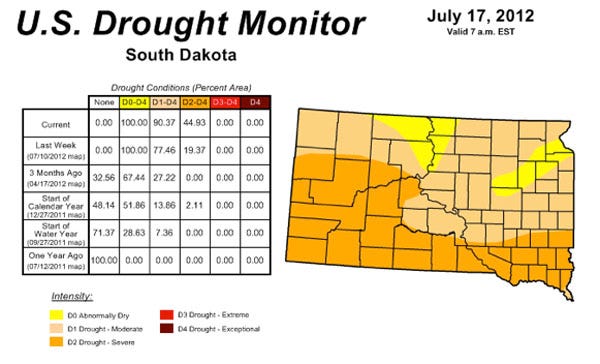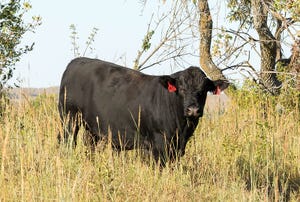Drought Monitor Update - 90% of South Dakota Is In Drought
The total drought area, at all levels, increased from 77% to 90% of the state's land area, says Laura Edwards, SDSU Extension climate field specialist.
July 23, 2012

In South Dakota, the area of severe drought doubled from 19% to nearly 45% the week of July 19, according to the U.S. Drought Monitor. The total drought area, at all levels, increased from 77% to 90% of the state's land area, says Laura Edwards, SDSU Extension climate field specialist.
"The expansion of drought is a result of continued above average temperatures, in combination with mounting precipitation deficits," Edwards said. "Vegetation greenness from satellite observations is showing much less healthy vegetation, particularly in the western and southeastern counties."

 For the year to date, precipitation is below 80% of average for most of the state, with some areas closer to 50% of average. The benefits of the storms that rolled through eastern South Dakota in April and May have long since gone, and dry conditions are returning with a vengeance, Edwards says.
For the year to date, precipitation is below 80% of average for most of the state, with some areas closer to 50% of average. The benefits of the storms that rolled through eastern South Dakota in April and May have long since gone, and dry conditions are returning with a vengeance, Edwards says.
"Reports from producers indicate that this summer's climate is taking its toll on row crops. "Windshield surveys", or views from roads and highways, indicate significant yield loss in the southeastern part of the state, which was downgraded from moderate drought (D1) to severe drought (D2) on this week's map. Some informal estimates are 75% or more average corn crop loss in that region," said Edwards on July 19.
Fields that were recently hayed and baled appear to be growing back with weeds, at a time when hay production is much lower than normal. Cattle auctions are getting busy, as some ranchers are culling herds, primarily in response to high hay prices and low forage availability. Water quality has also been of concern for livestock operations.
"Soybean fields are, so far, not impacted as hard as corn and pasture/hay. Producers may have noticed slower growth during the hottest and driest periods lately, but there is still time yet for a good soybean crop to develop," Edwards said. "One critical time for moisture for soybeans will come in a few weeks, when pods begin filling."
For the most current information on the drought, visit iGrow.org.
You May Also Like



